Early Primates : Evolution
Eosimias : Darwinius Masillae
Origins of Mankind
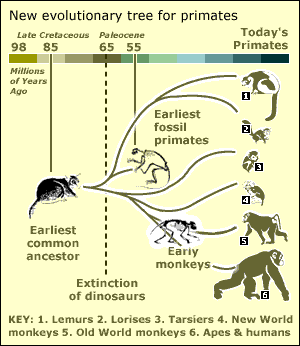
Credit: © The Field Museum, D. Quednau.
Existing primate species can be divided into six subgroups: lemurs, lorises, tarsiers, New World monkeys, Old World monkeys,
and apes and humans.
As reported in an article in the well-respected scientific magazine "Nature" in April, 2002 the
results of researches led by the Field Museum of Chicago have resulted in a revision of the evolutionary
tree for primates.
The early origin of primates has been pushed back from 65
million years ago to 85 million years ago, before the dinosaurs became
extinct.
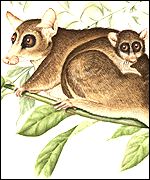 According to Dr. Martin vice president of academic affairs at The Field Museum and co-author of the research, who has studied primate evolution from
many different perspectives for the past
30 years, their 85-million-year-old early common ancestor of the primates probably looked like a primitive, small-brained version of today's
dwarf lemur.
According to Dr. Martin vice president of academic affairs at The Field Museum and co-author of the research, who has studied primate evolution from
many different perspectives for the past
30 years, their 85-million-year-old early common ancestor of the primates probably looked like a primitive, small-brained version of today's
dwarf lemur.
That animal would probably have been a nocturnal, tree-living creature weighing about 1-2 pounds, with grasping
hands and feet, also used by the infant to cling to the mother's fur. It probably had large forward-facing eyes
for stereovision and a shortened snout. It would have inhabited tropical/subtropical forests, feeding on a mixed
diet composed mainly of fruit and insects. Like humans, it probably had a slow pace of breeding characterized
by heavy investment in a relatively small number of offspring.
The illustration above left was prepared by Nancy Klaud to accompany the Field Museum's research findings.
From time to time new fossils are discovered which seem to offer a greater insight into very early primates
which may have featured in the evolutionary origin of mankind.
Two of the more accepted 'very early primates'
being known to science as Eosimias, (which translates
as Dawn Monkey), and Darwinius Masillae.
Eosimias seems to have lived all of forty-five million years ago and Darwinius Masillae all of forty-seven million
years ago.
Eosimias
The discovery, in China, of some fossilised foot-bones believed to be from Eosimias, an early species
already known of from fossilised jawbones, led to the announcement,
in 2000 A.D., of Eosimias as a candidate
for consideration as an early ancestor present in the family tree of humans / primates.
A graphic was subsequently published showing where the researchers would place Eosimias in relation to the origin of mankind.
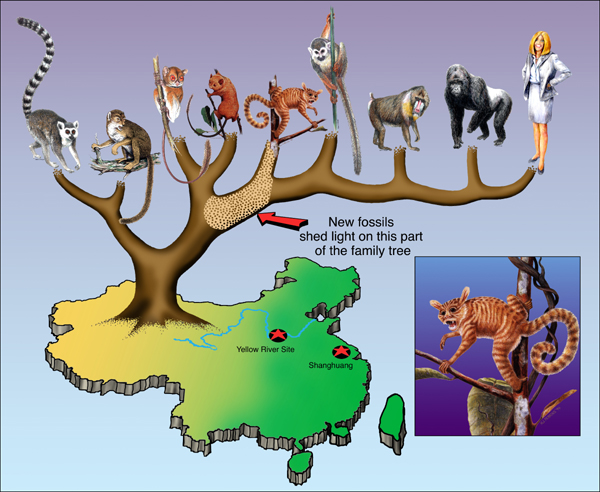
From left to right
the primate species depicted on the tree are: a
lemur (Lemur catta), an adapid (Hoanghonius
stehlini), a tarsier (Tarsius bancanus), an
omomyid (Shoshonius cooperi), a proto-monkey
(Eosimias centennicus), a South American monkey
(Saimiri sciureus), an Old World monkey
(Mandrillus sphinx), a great ape (Gorilla
gorilla), and a human (Homo sapiens).
Graphics by Mark A.
Klingler, Carnegie Museum of Natural
History
Darwinius Masillae
As recently as May, 2009, another fossil discovery - that of the Darwinius Masillae / Ida fossil - was
triumphantly announced, at a high-profile media launch hosted by the prestigious American Museum of Natural History in New York,
as a possible early ancestor in terms of the primates family tree.
This fossil, of creature beleved to be of an early adapid and seeming to bear both lemur-like and monkey-like traits,
dating from some 47 Million years ago, had been
discovered in Germany's famous Messel Pit where many astonishingly well preserved fossils of diverse
early species have also been unearthed.
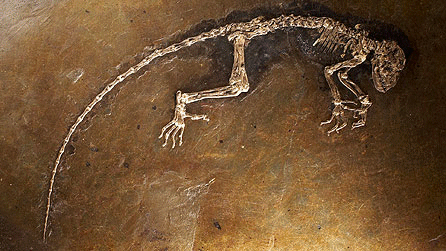
The Darwinius Masillae / Ida fossil was bought by a Museum in Oslo
from a German fossil dealer for $750,000
It very soon emerged, however, that the placing of the Darwinius Masillae / Ida fossil in relation to the
human evolution was open to dispute.
Whereas the research team directly involved seemed to give
Darwinius Masillae / Ida a definite candidacy as a potential great-great-great-greatn aunt of Human Beings
other prominent researchers, - including one Dr. Christopher Beard who had
been closely involved in the Eosimias foot-bones study and who was, as of May, 2009, curator of vertebrate
paleontology at Pittsburg's Carnegie Museum of Natural History, - saw Darwinius Masillae as being only
distantly related
in terms of the primate family tree, human evolution the origins of mankind.

A second new early adapid fossil discovery found in Egypt in 2001, dating from some 37 million years ago, that has been named Afradapis longicristatus, and is closely related to Darwinius, is described
(October, 2009) in
the prestigious science journal Nature by a team led by Erik Seiffert, of Stony Brook University in New York state.
Their analysis of the two fossils indicates strongly that both Darwinius
and Afradapis appear to be members of a group more closely related to lemurs and lorises than to monkeys, apes and people, which has left no known modern descendents.
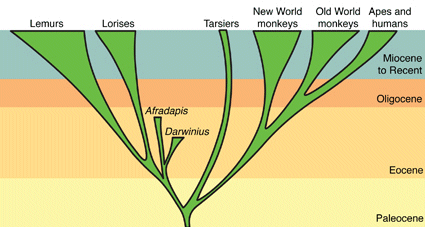
.gif)
|
|
In this tree, adapiform primates like Darwinius and Afradapis are not placed close to higher primates, but rather are situated as
closer relatives of the living lemurs and lorises, which are "prosimian" primates.
|
|
The team led by Dr. Seiffert record the surprising discovery that the first African primates to evolve large body size and tooth and jaw features like those of the living catarrhine anthropoids
(that is, the Old World monkeys, apes, and humans) arose from within this distantly related prosimian group (adapiforms) that includes Afradapis. Such early promisians could
have attained mature weights of 20 pounds (9 kilos) in contrast to the 1-2 pounds mature weight they attribute to the contemporaneous early ancestors of all later anthropoids.

One hearing of this challenge Dr Hurum, and some of his colleagues, went on the record in declining to fully accept the Sieffert teams conclusions.
Dr Hurum said: 'We expected a challenge like this and it's interesting it has taken five months for the first attack to come. What we claim about Ida is really quite controversial. We really trust and stand by our interpretation.'
Philip Gingerich, a palaeontologist-from Princeton University in the US who worked with the Norwegian on Ida, described the latest assertion as 'puzzling', adding that the creature was almost certainly part of the lineage that led to monkeys, apes and humans.


Image showing the relative extent of fossil discovery
Darwinius Masillae compared to Eosimias

There are many un-knowns in relation to early primates and their evolution. At age-of-the-sage we are more truly interested in the origins
of Human Psychology and Spirituality than in the origins
of Human Physique.
|
|
![[early primates, early, primates, evolution, family tree]](evolution.gif)
![[early primates, early, primates, evolution, family tree]](evolution.gif)



